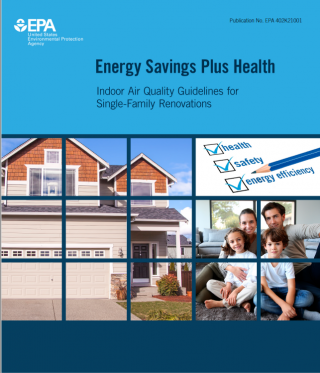Energy Savings Plus Health: Indoor Air Quality Guidelines
This resource will help ensure that home renovations and energy upgrades protect the health of Americans while saving energy and money.
On this page:
Purpose and Overview
Millions of American homes will be retrofitted in the coming years to improve their energy efficiency, repair or add building features, or make them “greener.” Integrated healthy home and energy-efficiency retrofit activities can simultaneously lower utility costs and improve indoor air quality (IAQ). Leading energy-efficiency retrofit programs have demonstrated the feasibility of integrating many IAQ and safety improvements. Home energy retrofit activities might negatively affect IAQ, however, if the appropriate home assessment is not made before work begins and issues that may affect IAQ are not identified and properly addressed. The U.S. Environmental Protection Agency (EPA) developed the Energy Savings Plus Health: Indoor Air Quality Guidelines for Single-Family Renovations to provide practical guidance on improving or maintaining indoor environmental quality during home energy upgrades or renovations that include energy efficiency.
Single-Family Housing Focus
These IAQ guidelines apply to existing single-family homes. EPA has a related document for multifamily buildings. Both documents provide guidance for conducting home assessments and undertaking the responses necessary to maintain or improve IAQ and safety. The IAQ guidelines also can help improve the quality of home weatherization projects and other energy-efficiency retrofit or remodeling jobs, thus reducing failures and repeat service calls.
Intended Audience
These IAQ guidelines are intended for use by the home energy retrofit industry—including energy-efficiency retrofit and housing rehabilitation professionals and contractors—and others engaged in energy-focused residential retrofit, renovation or remodeling efforts. They also are intended for voluntary adoption by federal, state, tribal and local weatherization assistance programs; federally funded housing renovation programs; industry standards organizations; private-sector home performance contracting organizations; and public and environmental health professionals.
Programs and contractors undertaking energy retrofit and renovation projects are encouraged to coordinate their services with local health and housing resources to provide families the support they may need.
What's Included in the IAQ Guidelines?
EPA's Energy Savings Plus Health: Indoor Air Quality Guidelines documents focus primarily on the health and safety of building occupants. The document identifies priority indoor environmental issues and includes Assessment Protocols to evaluate existing conditions, Minimum Actions to be taken during home energy upgrade activities, and Expanded Actions that provide opportunities to promote improved occupant health through home energy upgrades, as described below:
- Assessment Protocols are used to evaluate existing conditions of concern and the potential for additional concerns that could arise from energy upgrade activities.
- Minimum Actions include critical measures that home energy upgrade contractors should take to help ensure their work does not introduce new indoor air quality concerns or make existing conditions worse.
- Expanded Actions include additional actions that home energy updates contractors can take during a home energy upgrade project to promote healthy indoor environments.
The IAQ guidelines often refer to national standards and guidance; however, work should be conducted in compliance with state and local requirements as well. Supplemental guidance information is referenced. The document also includes appendices on worker protection and client education.
The IAQ guidelines are not intended to:
- Set new EPA regulatory standards
- Provide guidance on diagnosing occupant health problems or building-related illness
- Address emerging issues that have not been linked to adverse health effects
- Make training or training documents unnecessary
- Provide detailed guidance on how to achieve the intent of each recommendation in all situations or
- Identify funding availability or which programmatic funding sources should be used
How Should the IAQ Guidelines Be Used?
These guidelines were developed to assist Weatherization Assistance Programs (WAP) and other home energy upgrade and remodeling programs to support existing practices that improve the indoor environment and protect occupants. The IAQ guidelines provide additional guidance for those able to go beyond minimum requirements and incorporate additional health measures. EPA recommends that these guidelines be voluntarily adopted, in whole or in part, for the following purposes:
- Develop or enhance standardized training program requirements.
- Refine and update program performance standards, materials, and resources to continue to protect occupant health.
- Inform revisions to program funding rules if and where needs are unmet (i.e., specify allowable expenses for health and safety as appropriate).


